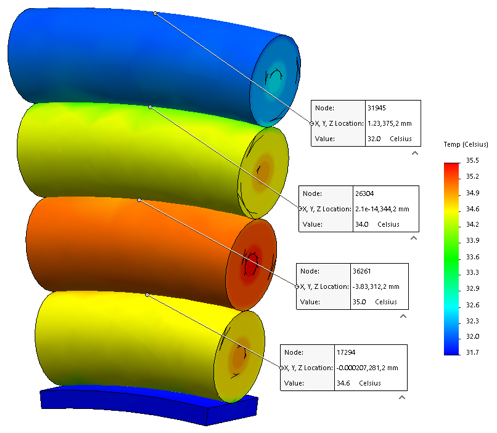Subsea cables are stored on land and (mainly) used in water. That means the temperature difference between deploying and retrieving can be high. Therefore, controlling the cable's temperature in-field is often a challenge.
Shallow and deep waters
When working with cables in shallow water, relatively less of the cable will be submerged while the rest of it is wound on a drum on the vessel. In deep water applications, where relatively more of the cable is deployed, water provides a cooling effect for the cable when it is subjected to electrical currents.
In contrast, in shallow water applications, cable layers are spooled on a drum on the vessel; these layers cannot benefit from the cooling effect. Eventually, the heat caused by the electric current flowing through the cable builds up.
Moreover, the increased amount of cable-layers further amplifies the maximum reached temperature within the cable. This phenomenon is explained by ‘Joule heating’:
 where P is the electric power in watt (W), I is the current in amps (A) and R is the cable resistance in ohms (Ω).
where P is the electric power in watt (W), I is the current in amps (A) and R is the cable resistance in ohms (Ω).
Verifying the subsea cable's temperature
It is vital to verify that the temperature of the cable will remain lower than a set maximum temperature while it is subjected to electrical power, as the cable components have temperature-dependent properties.
To support this, DeRegt has developed a bespoke thermal analysis tool for cables subjected to electrical power and spooled on a drum. This tool allows DeRegt to simulate the temperature and the heat transfer within and between the spooled cables. Estimating the maximum temperature that the cable will reach adds significant value to the entire cable design process. This type of analysis is crucial in specific cable design and application conditions.
Thermal Analysis in 5 steps
The developed thermal analysis tool consists of modelling and simulation processes. The following steps are performed during thermal analysis:
- Modelling Process
- Creating a cable model.
This includes simplifying the cable design and calculating the related properties (diameter, weight, density, conductivity, specific heat, conductor resistance, etc.). This model is drawn in 3D as a slice of layered cables (Figure 1). The previously defined properties are assigned to this 3D model.
.png?width=300&name=1.Model-%20a%20slice%20of%20the%20layered%20cables%20on%20the%20drum%20(a).png)
Figure 1. Model- a slice of the layered cables on the drum (a) - The heat power is calculated by using the current and duty information combined with the previously calculated resistance.
- Creating a cable model.
- Simulation Process
- Defining the boundary conditions.
- Running the simulation (Figure 1).
- Evaluating the results (Figure 2).
 |
| Figure 2. Result of the thermal analysis |
Thermal analysis is performed by applying the finite element method to calculate the temperature distribution within a solid structure, which is due to the thermal inputs (heat loads), outputs (heat loss), and thermal barriers (thermal contact resistance) in the model. Thermal analysis solves the conjugate heat transfer problem with the simulation calculation of thermal conduction, convection, and radiation.
This thermal analysis tool is then validated against actual test values.
Testing and Analyzing your Subsea Cable
Eager to learn more about various tests and analyses for subsea cables, like Thermal Analysis explained in this blog?
In our E-book on Testing and Validating, our cable experts explain why this is crucial for your subsea projects' success. Learn more about which aspects must be tested thoroughly and when an analysis is sufficient. Download the E-book for free here:



